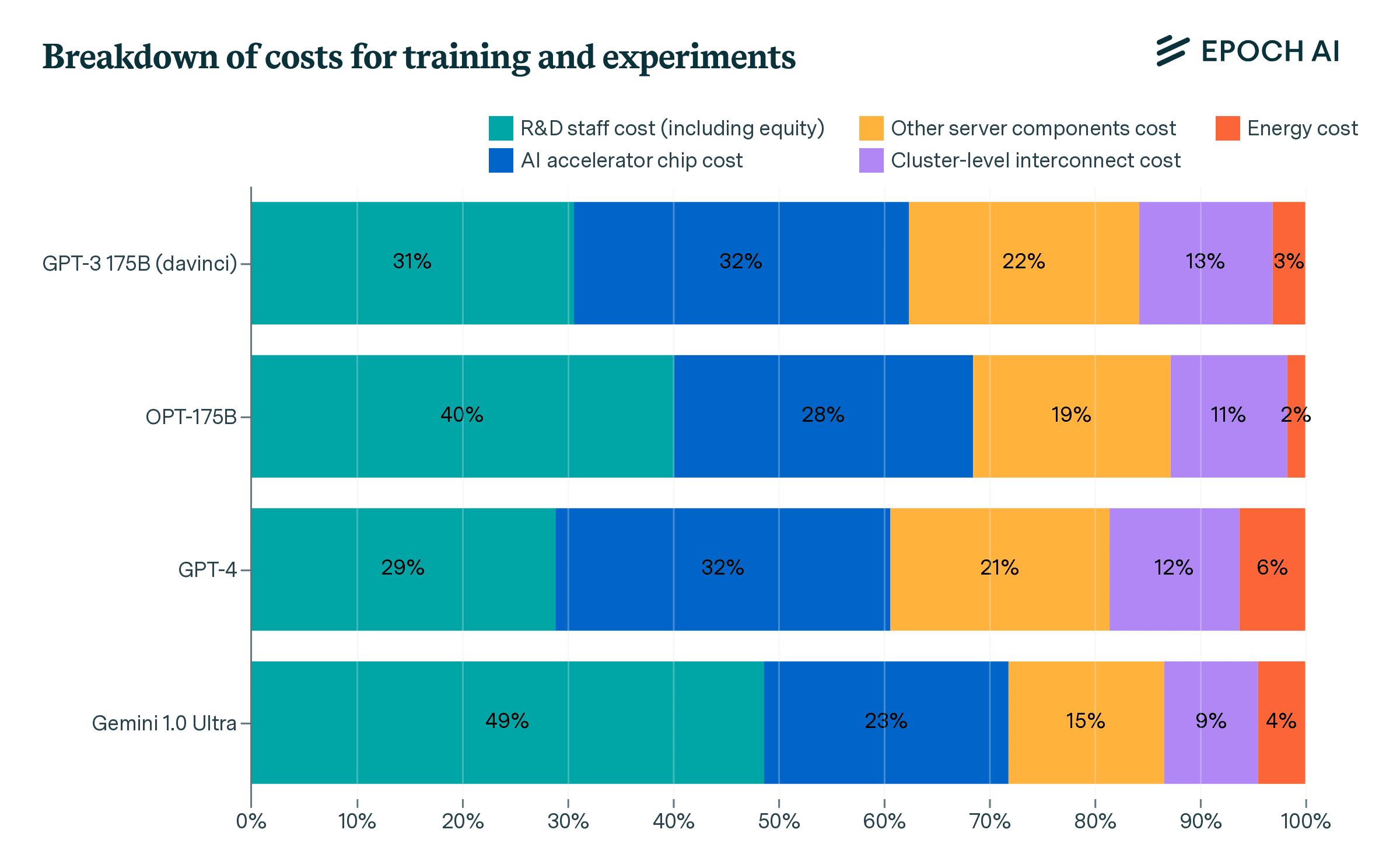Today, we have a plethora of free AI tools at our fingertips like ChatGPT and Google Gemini. While using them doesn’t cost you money directly, anyone who paid attention in high school economics class would know that there’s no such thing as a free service. AI is an incredibly expensive technology, and its costs manifest themselves in several ways. What’s the true cost of AI technology?
This is a bit of a tough question to answer because we’re not just talking about the money that end users pay. The costs of AI affect millions, if not billions, of people across several industries, and we’re just starting to see some of the effects of this. What makes things worse is that the costs are increasing. They’re increasing at possibly the worst time with everything else happening in the world.
The true cost of AI affects to users
Let’s start with how much you’re paying out of pocket. At this point, things seem pretty clear when it comes to what AI features you pay for. Companies let you use their most basic AI features for free, and if you want some more advanced features, you’ll just pay a monthly fee. This is how companies like OpenAI, Google, Perplexity, and others operate.
There’s also the AI that comes pre-installed on devices like Samsung’s Galaxy AI and Apple Intelligence. These tools are also free to use with the only cost being the cost of buying the device for the most part.
But here’s a question, you don’t expect things to be like this forever, do you? The sad fact is that this is going to change, and the companies know this. They knew this from the get-go. Free features are going to go behind paywalls and the cost of hopping those paywalls is going to rise as time goes on. We haven’t seen it just yet, but companies are getting ready to start making changes.
Price increases
For example, OpenAI plans to raise the price of ChatGPT Plus from $20/month to $22/month by the end of the year, and it plans to raise it to $44/month within the next five years. The company is aware that the price that they’re charging right now is not sustainable. This isn’t just specific to OpenAI; pretty much all companies developing AI tools know that the prices they’re charging aren’t going to keep their boats afloat for long. These are introductory prices we’re paying now.
Temporarily free
When it comes to free platforms, we’re going to start seeing the number of free features diminishing as time goes on. Right now, Google is letting people try out a ton of free features. We’re talking about some rather advanced features like AI Overviews, Audio Overviews in NotebookLM, Gemini in Gmail, and others. It’s not out of the kindness of the company’s heart.
Google is letting free users try the features so that they can test them out while Google works out the kinks. The company is going to lock some of these features behind a paywall after the testing is done.
Those of you with Galaxy AI and Apple Intelligence, you’re not safe either. We heard soon after Samsung introduced Galaxy AI, that the company was considering charging to use it by the end of 2025. We’re not sure how much money Samsung is going to charge and we don’t know what features will be pay-walled. The fact is that some or most of the features that people are enjoying today could cost money after next year.
Apple is even considering charging people up to $20/month to use some of its AI features eventually. When Apple Intelligence finally launches to the masses, users will be able to use them for free, but not forever.
And people don’t know
The really messed-up thing about this is that many of the users have no idea that the companies are even considering charging them for these features. You’d have to be deeply planted in the tech news circuit to catch wind of what these companies are doing. The majority of people using AI have no idea that the features they’re using for free could cost money tomorrow.
The cost to companies
It’s true that AI can cost the user. While rising prices and temporarily free features will cost you money in the long run, the companies developing AI tools are paying a massive bill today. One thing that people don’t know is that the companies training AI models and deploying AI features are doing so at a loss; a MASSIVE loss. It costs tens of millions of dollars to train and maintain these AI models, and that cost trickles down to the users. This is why the free features you’re using won’t be free forever. Using them costs the companies more money than you’d think.
According to a paper by Epoch AI, it cost Google an estimated $29 million+ to train Gemini 1.0 Ultra, and that was just for the hardware and energy. The report estimates that the company spent more than $191 million in cloud compute resources training the model, and this was just at the time of publishing. It doesn’t take into account the continued training and maintenance of the model.
The same report states that OpenAI spent more than $40 million in hardware and energy and $78 million in cloud compute resources training GPT-4. Again, this is just at the time that the model was published. These aren’t even the companies’ most powerful models.
Breakdown of costs
Nearly half the cost of training Gemini 1.0 Ultra was on R&D staff (49%). 23% was on accelerator chips, 9% was on cluster-level interconnects, 4% was on energy, and 15% was on other server components. OpenAI spent far less on R&D (29%) and far more on accelerator chips (32%). It spent 12% on cluster-level interconnects, 6% on energy, and 21% on other server components.

Since these models came out, we’ve gotten models like GPT-4o and Gemini 1.5 Ultra. We can only imagine how much more these models cost to train.
Another thing to mention is that these costs only apply to training the models. What we also have to consider are the cost of paying the developers, continued upkeep of the models, etc.
Profit? What profit?
You might be thinking “How could they be losing money if they charge subscription fees?” The answer is that the money they’re getting from subscriptions is just dampening the financial burden of training their models. It’s like how Disney rakes in millions and millions of dollars from Disney+, but that service hasn’t made a cent of profit. The cost outweighs the income.
For example, at the time of writing this, OpenAI is now looking for another round of funding to help it reduce the sting of its costs. The company predicts that it will make about $3.7 billion by the end of 2024 in revenue. That’s not too shabby, but that’s outweighed by the $5 billion in business costs. We discovered this during the announcement that the company is raising the price of ChatGPT Plus over the next five years.
This is pretty scary because OpenAI is arguably the most popular AI company. More people pay for its AI tools than other companies, and they’re charging a comparable amount each month for their subscription services. So, it’s likely that OpenAI is making the most money purely from AI, and it’s not turning a profit.
So, other major brands like Google, Amazon, Microsoft, xAI, and Meta, are most likely paying much more and earning much less from their AI.
The prices are going to rise
Just like everything else, big brands made AI a massive profit-driven rat race. This means that they’re all fighting to outdo the competition. As such, these companies are increasing their efforts to build the best AI models, and this means that the costs are going to go up. The more powerful these models get, the more money it’s going to cost to maintain them, and the more money they’ll charge their users.
This is a trend that won’t stop because each company HAS to be the best on the market. No company wants to fall behind the competition; it will piss off the investors and make its users migrate to other services.
According to Epoch AI, the cost of training AI models has more than doubled each year since 2016. Back in 2016, the average cost of training a model was north of $5k of hardware and energy costs (10k for cloud compute resources). By the beginning of 2024, the average sat at about $9 million for hardware and energy (around $2 million for cloud compute resources).
The costs are going to continue to grow as companies try to finally craft AGI (artificial general intelligence). As the prices grow for the companies, they’re going to grow for the smaller brands and services utilizing these models. Not every AI service has its own model. Many of them license pre-existing models from these companies to generate their own content. Over time, it’s going to get more expensive to use these models, and those costs will trickle down to the consumers using their products.
The data cost
The true cost of AI doesn’t only involve money. These AI models probably wouldn’t function without a ton of data collected from years of internet and real-world content. Models need content to “learn” from the world, but the issue is that much of that content was created by people, and it’s being collected without their consent or knowledge.
What introduced people to this fact was learning about DALL-E back in 2022. We found out that, in order to create the then-crude AI-generated images, OpenAI had to scrape millions of images from the internet, and this included images that artists and photographers uploaded. That was just the beginning. As time went on, reports started to surface that several companies had been scraping content from news websites and even from social media posts. This had been going on for years, and we were none the wiser.
It’s possible that most of the social media posts that you’ve been posting for the past couple of years have been scraped and used to train models without your knowing. This is news to sour your palette, especially if you’re a creator. Obviously, if you create content, you’re likely to share it on Twitter (X.com), Instagram, Facebook, Reddit, or other platforms. Well, none of these platforms come out and tell you “Wait! Before you press that ‘Publish’ button, we’re going to scrape your content to train our model!” So, tons of people have been dumbfounded to find out that much of their content was scraped.
It gets worse because the big businesses are making it worse
The only thing that makes this worse is that the companies stealing your data are making it legal. Rather than respecting the fact that users don’t want their data scraped, they put that they scrape your data in their terms of service. So, the fact that they tell you makes it technically legal. This information is buried deep within the terms and coated in a layer of literary perfume like “Some of your data may be used to help improve the experience… blah blah blah.” They just don’t want to outright say that they’re scraping your data.
Also, the opt-out buttons are buried in settings to the point where you have to literally look up guides on how to opt-out, and that’s only for regions where the law requires an opt-out option. If your region doesn’t have an arm-twisting law in place requiring companies to provide an opt-out option, you can bet that there won’t be one.
Some companies are sneaky like X.com. You can opt-out of having your data scraped, but it’s not available on the app…. for some reason. So, you’ll have to use your computer which is less convenient.
Another way that businesses are making this worse is that the companies whose products we use are cutting deals with AI companies to hand over your data. For example, Reddit made a deal to hand over all of its data to Google. In a flash, Reddit just became a content farm for Google, and the users are the animals. Also, LinkedIn scrapes data to most likely train Microsoft’s models. Companies are making deals with these AI companies to hand over their users’ data, and people don’t know about it.
More time, more data
Just like the monetary cost of AI, the data cost is going to grow as time goes on. The more powerful companies want their AI models to be, the more data they’re going to need. This means that companies are going to need to find more ways of getting data and content. This means that it’ll get increasingly harder to post anything to the internet that won’t be intercepted and used to train a model. More and more of your data will be stolen as time goes on.
Paying the price
We’re still at the very beginning of our AI age, and we’re going to be for a while. As such, we’re still rather ignorant about the potential consequences of our actions. How much will it cost to train a model in five years time? How much will it cost to use that model? Will there be any platform on the internet that doesn’t scoop up your data? These are all questions that we ask today, and we’re too frightened to know the answer.
If this trend continues, then not enough people are going to want to invest in AI technology either by direct investments, API access, or subscription services. We know that the price of our AI world is high, but the true cost might be higher than we think.









